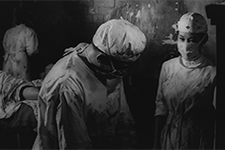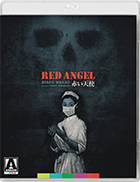Red Angel (Akai tenshi)
|  Yasuzô Masumura was both a prolific studio-contract director who churned out movies at the rate of three or four per year for Daiei and a conformity-bucking iconoclast who helped define the early contours of the Japanese New Wave with his directorial debut Kisses (Kuchizuke, 1957), a romance about a young couple whose fathers are both in prison. Masumura was an avid moviegoer as an adolescent, studied filmmaking on scholarship at the Centro Sperimentale di Cinematografia in Rome, and worked for a short time as an assistant to both Yasujiro Ozu and Kenji Mizoguchi before launching his own career, which spanned nearly three decades and almost 70 feature films. His work was contemporaneous, but largely distinct from, other notable figures of the Japanese New Wave, including Seijun Suzuki, Shohei Imamura, and Nagisa Oshima, the latter of whom wrote glowingly as a critic about Kisses, tagging it as a film in which “the new generation took its place in Japanese cinema as an intense, irresistible force that no one could ignore.” Intense is an appropriate word for Masumura’s films, many of which revel in visual and tonal excess and play their melodrama seriously, which is perhaps why he is so often compared to the American maverick independent filmmaker Sam Fuller. That comparison is particularly apt in considering Red Angel (Akai tenshi), which is exactly the kind of no-apologies war-is-hell psychodrama that Fuller would have made. Set almost entirely within various field hospitals along the front line of the Sino-Japanese War in China in 1939, the story follows Nurse Sakura Nishi (Ayako Wakao, who appeared in more than 20 of Masumra’s films), a gentle soul in a hellish environment who wants nothing more than to help the men around her, all of whom are wounded physically, psychologically, spiritually, or some combination. She is surround by the ravages of violence and is herself a victim, falling prey to a gang of sexually ravenous soldiers led by Private Sakamoto (Jôtarô Senba) who rape her. When later confronted with Sakamoto after he has been fatally wounded on the front lines, where he has been sent as punishment for the assault, she does everything she can to save him just so he knows that she has no desire for vengeance. Much of the film concerns her relationship with two damaged men. The first is a soldier (Ken’ichi Tani) who has lost both of his arms. In a desperate bid to console him, she provides him with sexual favors, but it turns out that her efforts were in vain and only made things worse for him. She also develops a long-terms relationship with the head of the field hospital, Dr. Okabe (Shinsuke Ashida), whose experiences amutating hundreds of limbs as the only means of saving lives has left him depressed, cynical, and addicted to morphine. More so than any character in the film, Dr. Okabe represents the ravages of war, as he sees day in and day out the horrors of bodies mutilated by bullets and shrapnel and can do little more than cut off the most damaged parts, leaving the men alive, but permanently disfigured and disabled—potent symbols of the cost of not just war, but the kind of unchecked aggression that defined the militaristic imperialism of Japan and was seen with such a critical eye by subsequent generations. Based on a recently published novel by Yoriyoshi Arima, himself a war veteran, Red Angel was adapted by the prolific screenwriter Ryôzô Kasahara. It was the third of three war films Masumura made between 1965 and 1966, the previous two being Seisaku’s Wife (Seisaku no tsuma, 1965), a homefront melodrama set at the beginning of the Russo-Japanese War, and Hoodlum Soldier (Heitai yakuza, 1965), the first in a series of nine yakuza (gangster) films featuring a former gangster and a conscientious objector who are drafted into the Japanese army. Red Angel is distinct from both of those films, though, as it grounds its human drama in the grisly realities of war, eschewing the cathartic comedy of Hoodlum Soldier and the homefront setting of Seisaku’s Wife (although all three films can be viewed as critiques of Japanese militarism). Red Angel is a raw, bloody, uncompromised drama that takes as its central subject the destruction of humanity as seen through the mutilated soldiers and the psychically scarred medical personnel who must attend to them. The film was shot in widescreen by cinematographer Setsuo Kobayashi, who spent five years on the front lines of World War II. He had already shot nearly 30 films in less than a decade, one of which was Masumura’s Hoodlum Soldier and another of which was Kon Ichikawa’s brutal war film Fires on the Plain (Nobi, 1957). Throughout Red Angel, Masumura and Kobayashi favor long takes and wide shots, rarely move in for anything that might be deemed a close-up. This keeps the characters constantly trapped in their environs, surrounded by wounded soldiers and chaos. The sustained air of violence is both lyrical and documentary-like (the opening credits are placed over actual war photographs, ending on piles of skulls). Even the moments of respite in Dr. Okabe’s private quarters have a suffocating sense of enclosure, as if the war is ready to break through the walls at any moment. Wakao, who had already starred in 15 of Masumura’s films, and Ashida are both excellent in their respective roles, and even when their relationship turns conventionally romantic when she helps him kick his morphine addiction and reclaim his sexuality, it still has the dark edge of assurance that the horrors of war are always just a breath away.
Copyright © 2022 James Kendrick Thoughts? E-mail James Kendrick All images copyright © Arrow Video | |||||||||||||||||||||||||||||
Overall Rating: 


 (3.5)
(3.5)


